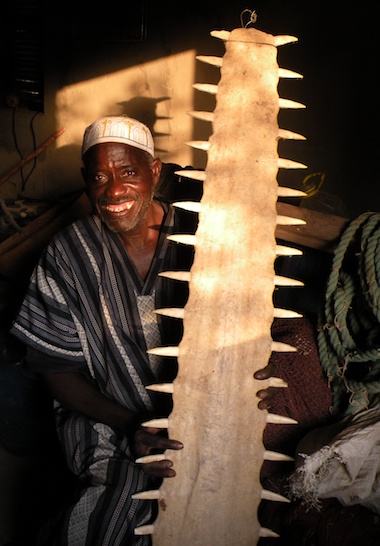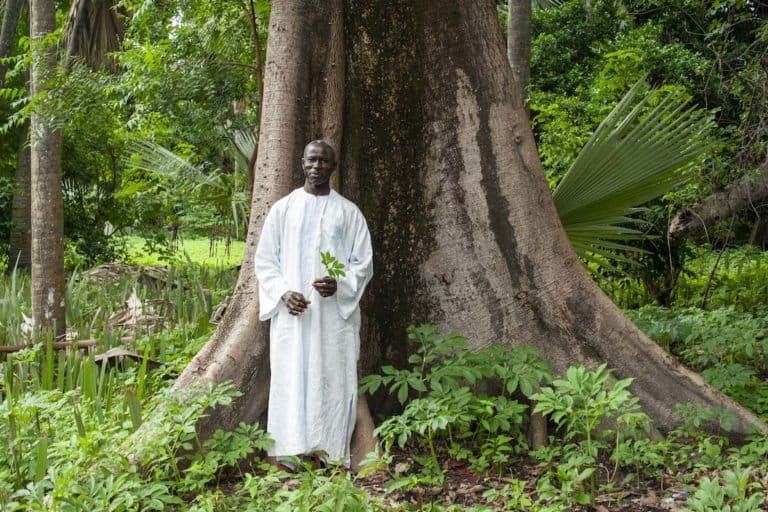- In the mid-2000s, villagers from the Jola ethnic group in the Casamance region of Senegal noticed a decline in local fish stocks and forest cover, and an increase in water salinity, all of which threatened their food supply and way of life.
- They formed a fishing association in 2006 that grew into a community-wide conservation group known as the Kawawana ICCA in 2010, and have since turned their dire situation around by reviving traditional fishing and forestry methods.
- As part of that effort, the Kawawana ICCA established a team to check up on the state of the river and forest, counting birds, fish, crocodiles, otters and dolphins, whose presence indicates healthy fish stocks, and monitoring rainfall and river salinity.
- Bassirou Sambou, 53, a fisherman by trade, heads that effort. Mongabay interviewed him as part of a larger reporting project about the Kawawana ICCA.
Senegal: After reviving fish and forests, Jola villages tackle new threats
Women’s work in Senegalese conservation includes exorcising demons
MANGAGOULACK, Senegal — Bassirou Sambou heads the biodiversity monitoring section of the Kawawana ICCA, a group of 12,000 residents of eight villages in the Casamance region of Senegal. The group has succeeded in repopulating fish stocks in their river, halting deforestation and attracting wildlife to their area.
In the mid-2000s, villagers began to notice that their channels of the Casamance River were nearly empty of fish and that deforestation was contributing to the rising salinity of the water, threatening the availability of cultivable land.
They formed a fishing association in 2006 that grew into a community-wide conservation group in 2010, and have since turned the dire situation facing their families around. In many cases, their methods involve returning to the way their ancestors managed the landscape, such as marking protected areas with fetishes to indicate that certain activities are prohibited. Ignoring fetishes can unleash evil spirits and bring bad luck, according to local custom.
Kawawana means “our local heritage to be preserved by us all” in the Jola language, which is spoken by the ethnic group of the same name to which the community belongs. ICCA is a quasi-acronym denoting traditional lands conserved by indigenous and local community groups.
In 2009, the Kawawana ICCA established a biodiversity division to monitor the environmental state of the river and forest. Sambou, 53, leads patrols for the division several times a year to count and observe fish, crocodiles, otters and dolphins, whose presence indicates that fish stocks are healthy.
Over the first three years of the division’s work, his team found that the average catch increased from 1 kilogram per hour to 4 kilos per hour (2.2 pounds to 8.8 pounds). Salinity levels dropped by 20 percent during the same period.
Mongabay interviewed Sambou in his home village of Mangagoulack to find out how his community had succeeded in halting environmental disaster and economic ruin almost entirely without outside assistance.

Mongabay: Which animal species do you look out for as a sign that the fish population is healthy?
Bassirou Sambou:There are some species, like otters, that feed on fish and when we consider that there is a huge return of these animals [since 2009], that shows that there is something for them to eat. Otherwise they will go elsewhere.
There are also certain bird species, such as cormorants — a piscivore — pelicans and larks, and egrets, which we also track.
There are also crocodiles in the freshwater areas, which now proliferate. We look for them mostly at night with the help of a torch.
How often do you take stock of these animals?
We check at different points of the year in groups, around three times a year. Some of us go out in the pirogues, and we count. We check the numbers and the species.
We have now been doing this for five years but we started working on it much earlier, without having all the right techniques. Then we had a trainer in from Bordeaux who taught us how to do this systematically. We have representatives in each of the eight villages.
Why are these species important, beyond indicating the presence of fish?
They are important for [potential] ecotourism, and so that future generations can see these species here. Otherwise people will kill them all [specifically crocodiles] and we will have to go far away to see them.
It’s better to preserve them. They are part of the marine landscape.

How are you received by your community and how do you reach out to others in Casamance?
We do everything as volunteers, but we lack money.
At the beginning we were met with a lot of reticence, because there are people who eat crocodiles, for example. Their flesh is very sweet and tender.
We have organized radio programs and people call in to ask questions or make comments. That helps people in the region understand that the environment is being protected.


What about fishing, which is your main focus?
We need to keep fishing, but in a sustainable way. People were fishing with monofilament nets, but when we started raising awareness they stopped. We use [the nets] to build enclosures for the livestock now.
Our ancestors were into conservation, and these were not people who went to school and learned it there. They had this idea, that you had to fish little by little so that it would last for future generations.
Everywhere in the world now, we see that the oceans are getting worse with overfishing. There are also animals that need [fish], and with climate change we are afraid that all will be lost.
This year, the rain was not at all abundant. A dozen kilometers from here it didn’t rain at all. When there is a lack of rain the amount of salt in the water rises. We check the level of salt in the water, and in previous years when there was excess salt, the mangroves were dying.
When there are no small fish [which grow among mangrove roots], there are no large fish.
Beyond surveillance, how else have you helped conserve the environment?
We also got involved in the reforestation of the mangroves. That also helped us to fight climate change.
People are cutting them down. People come here to cut down green wood, and that is something that was prohibited by our ancestors; they just took the minimum to build the roof of the house, because [the houses] were also constructed with straw.
We limited that activity, so you can’t take [young wood] out of the village. People from Ziguinchor [the regional capital] will come and cut the wood and then they will leave it somewhere for a year to dry it out. Then they sell it. We have successfully slowed that down.
During the rainy season, when we start sowing rice, no one even takes a stick of green wood. We take someone from the village where we go, to see if trees have been cut down.

Is there anything else you regulate within the Kawawana villages?
When the rain falls, we don’t pick oysters. The oysters grow during the rainy season, so nobody touches them. When we started our conservation project, we found a slot from February to June that became the oyster harvesting season. This year we changed, and just did March, April and May.
Long ago, it was well organized, and there were certain areas where no one fished because the traditional fetishes were placed there. People were afraid that their whole family would be affected.
What changed?
When boats with motors appeared [in the 1980s], the engines and monofilament nets, there was more money around. There were fishermen coming from the north, and even from Guinea-Bissau, to come and fish here. They thought the supply was infinite. It was not. They plundered our rivers. Species started to disappear and we said no: this has to stop.
That’s when we started having meetings with other villages and we met the authorities, met with the village elders. We started to draw up rules to correspond with the existing legislation. We had to work with technical specialists in the local government. We brought them in.
It wasn’t easy. It took us around four years to get recognition as an ICCA.
Why is Kawawana important for indigenous communities?
This isn’t just fishermen’s business; this is everybody’s concern.

Jennifer O’Mahony is a freelance journalist working across West Africa. Her Twitter handle is @jaomahony.
Editor’s note: This interview has been translated from French and lightly edited for clarity and length.
FEEDBACK: Use this form to send a message to the editor of this post. If you want to post a public comment, you can do that at the bottom of the page.














